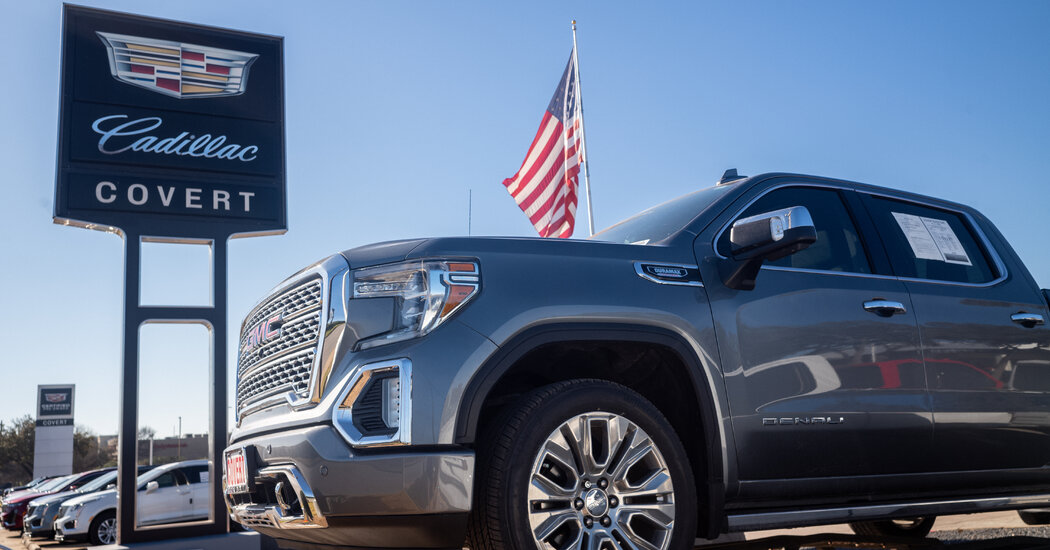
General Motors on Tuesday reported an 18.5 percent drop in profits in the first quarter, mainly because of the cost of job cuts and slowing new-vehicle sales in China. The company also announced that it would build a fourth battery factory in the United States.
The decline comes as higher interest rates raise the cost of new vehicles for consumers and worries persist about a possible recession in the United States.
G.M. said its net income in the first three months of the year fell to $2.4 billion, from $2.9 billion in the same period in 2022. Revenue in the first quarter rose 11 percent, to $40 billion, thanks to higher prices and effective discounting.
“The first quarter came in ahead of our own expectations, primarily as a function of pricing and a consistent incentive plan, as well as demand remains strong for our vehicles,” G.M.’s chief financial officer, Paul Jacobson, said in a conference call.
Globally, G.M. sold 1.4 million vehicles in the first quarter, 3 percent fewer than the same period last year. Its U.S. sales rose 18 percent, but its sales in China fell 25 percent.
The automaker’s first-quarter earnings were lowered by $900 million, which G.M. had set aside to cover the cost of severance and other measures resulting from its elimination of 5,000 salaried jobs. In total, G.M. is trying to cut about $2 billion a year in costs.
The effect of those cost-cutting efforts, Mr. Jacobson said, is “flowing to the bottom line quicker than we anticipated.”
Because of the job cut expenses, G.M. lowered its net income outlook for 2023 slightly. The company said it now expected 2023 net income to range from $8.4 billion to $9.9 billion. In January, it gave a range of $8.7 billion to $10.1 billion.
The auto industry’s trajectory remains uncertain. In the United States, sales of new vehicles rose about 7 percent in the first quarter, to 3.6 million vehicles. But the pace of sales slowed noticeably by March. Much of the increase had stemmed from purchases by rental-car companies and other commercial fleets, rather than individuals.
Rising interest rates and near-record prices have made it hard for many U.S. consumers to afford new cars and trucks. In March, car buyers paid an average of $48,008 for new vehicles, up nearly $1,800 from March 2022, according to Kelley Blue Book, a market researcher. The average monthly payment on new cars last month was $784, compared with $683 a year earlier.
While G.M.’s U.S. sales rose in the first quarter, signs of softening consumer demand in the broader market have started to appear. Last week, AutoNation, the largest auto retailer in the United States, said its new-vehicles sales fell 2 percent in the first quarter.
“There is a lot of mixed economic signals in the market, and within auto retail, which do warrant, I think, a more cautionary approach than the past few years,” AutoNation’s chief executive, Mike Manley, said in a conference call.
One big area of growth for the auto industry is electric cars. G.M. said Tuesday that it would build a battery plant with a South Korean partner, Samsung SDI. The two companies will jointly invest $3 billion in the factory, but did not disclose a location. G.M. is working with another South Korean company, LG Energy Solutions, at a battery plant in Ohio that has started production, and on two others that are under construction in Tennessee and Michigan.
G.M. is hoping for a surge in sales of electric vehicles this year. In the first quarter, the company sold more than 20,000 E.V.s in the United States. Mr. Jacobson said G.M. expected E.V. production in the first half of the year to top 50,000, and about double that in the second half.
“We feel good about the demand being robust for the electric vehicles we are producing,” he said.
One reason G.M.’s sales fell so much in China is that consumers increasingly prefer electric cars. That has created a big opening for Chinese manufacturers and hurt Western automakers that have been slow to roll out electric vehicles.
In the United States, G.M. has started making a new generation of electric vehicles using modular battery packs made at the Ohio plant. The Cadillac Lyriq, an electric sport utility vehicle, and the GMC Hummer are in production, although G.M. sold fewer than 1,000 of those models in the United States in the first three months of the year.
Later this year, G.M. plans to introduce three models that will use the same modular battery packs. An electric Chevrolet Silverado pickup is expected to arrive around the middle of the year, followed by the Chevrolet Blazer and Equinox S.U.V.s.
G.M.’s top-selling E.V. is the Chevrolet Bolt compact, which accounted for almost all the E.V.s that G.M. sold in the United States in the first quarter. The Bolt has been on the market since 2017 and uses an older battery design. G.M.’s chief executive, Mary T. Barra, said on Tuesday that the company would stop making the model at the end of this year.
In 2021, G.M. recalled all the Bolts made to that point to replace their battery packs after it found that a manufacturing defect had caused fires in a small number of them. After halting production to address the problem, the company resumed Bolt sales in 2022.
G.M.’s stock was down about 2 percent on Tuesday morning after its earnings report.













